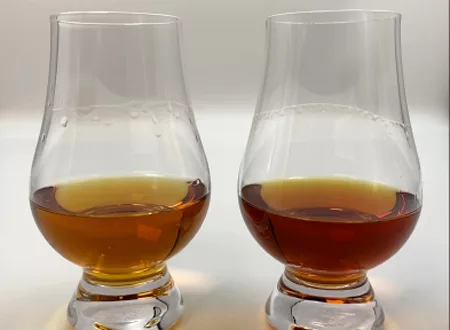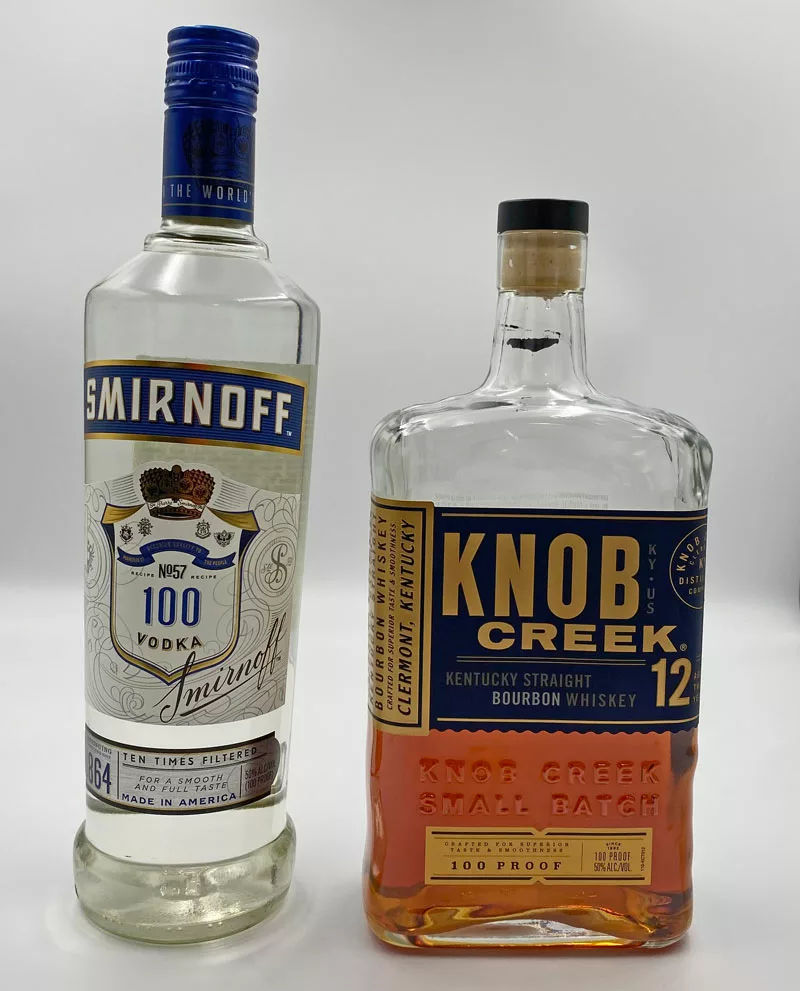
how do whiskey legs form?
What Are Bourbon Legs?
What do bourbon legs tell us about a whiskey?
What are Bourbon Legs and What do they Tell us about a Bourbon or Whiskey?
What are bourbon legs (whiskey legs, wine legs…also called tears), how do they form, what if anything, do they tell you about the whiskey before you even taste it? This question led to the following research, tests, and conclusions. First, the questions that I had:
- What creates bourbon legs? There are 2 theories:
- Only the alcohol affects the legs.
- Alcohol proof plus congeners (fatty acids, tannins, and other components from the barrel aging process) can also impact the legs, increasing the time for the legs to form and fall.
- Does the proof of a whiskey impact the thickness, time to form, or the length of the legs?
- Does a whiskey’s age/time in the barrel impact the legs?
- Does a higher proof whiskey form MORE legs, and/or, do the legs from higher proof whiskeys fall more slowly than lower proof whiskeys?
So, I created a variety of tests to try to prove/disprove these questions and I have video recorded the tests so you can assess for yourself if my conclusions are correct, or horseshit! The tests are further down the page.
What are Bourbon Legs and How do they Form?
When you swirl a glass of bourbon (or whiskey or wine), you will notice a film around the inner edge of the glass, and if you wait and watch for a bit, you will see streaming legs (sometimes called tears) form and drip down the sides of the glass. At first, you will see a thin “crown” form at the top of the swirl. After a bit, small beads will form, and eventually those beads will stream down the sides of the glass as legs or tears.
This is scientifically known as the Marangoni effect. Whiskey is essentially made of two components, alcohol and water. While in the bowl of the glass, they are homogenously mixed together. But when you swirl the glass, now you have two versions of the whiskey, one with the higher alcohol content in the base, and the other with a thin layer of whiskey on the sides of the glass. Since alcohol evaporates much faster than water, this thin layer of whiskey on the sides of the glass quickly becomes higher in water content than alcohol.
The water molecules are drawn to other water and since water has a higher surface tension than alcohol does, the water draws more strongly on the surrounding whiskey, both on the sides of the glass and in the bowl. The Marangoni effect means that the water molecules from the base and sides of the glass will be pulled up the sides of the glass to the water at the crown (i.e. is attracted to the higher water density at the top of the crown and away from the lower water content in the bowl).
The effect defies gravity because the water is being drawn upwards, until it becomes heavy enough to form tears (legs) and streams back down the sides of the glass.
The Tests
So, here are the tests I devised:
There is a lot of debate and differing opinions on what affects the length of time for the legs to form and how long it takes for them to begin falling from the crown. Some say that only the alcohol proof affects the legs and others say the proof AND congeners from the barrel (in the case of whiskey/bourbon) impact the forming of the legs.
1. What Creates Bourbon Legs?
There are 2 theories:
- Only the alcohol proof affects the legs.
- Alcohol proof plus congeners (fatty acids, tannins, and other components from the barrel aging process) can also impact the legs, increasing the time for the legs to form and fall.
To evaluate these two theories I’m using the following products for the test:

Test #1: Smirnoff 100 proof Vodka -vs- Knob Creek 12-year 100 proof
This test uses two alcohol products, both with the same proof but one is highly distilled (the vodka) and the other is aged in oak barrels for 12 years. If only the proof affects the formation of the legs, then both products should develop legs in a very similar timeframe. But if time in the barrel also affects the legs (by adding congeners) then the Knob Creek 12 year will develop legs at a noticeably different rate.
In the video, remember to adjust the time for the vodka legs to form by about minus 3 seconds because of the time it took to swirl the glass after the bourbon. You can see beads begin to form on the Smirnoff after about 7 seconds, and on the Knob Creek 12-year after about 17 seconds.
| Do Congeners Affect Legs or is Alcohol Proof the only Factor? | ||
| Smirnoff Vodka 100 proof | Knob Creek 12 yr Old 100 proof | |
| Beads to form on Crown | 7 seconds | 17 seconds |
| Legs to Begin Falling | 14 seconds | 23 seconds |
| Legs to Fall to Bottom | 32 seconds | 60+ seconds |
2. Does the proof of a whiskey impact the thickness, time to form, or the length of the legs?
Need two whiskeys that are the same age but different proofs.

Test #2: Calumet Farms 15-year 105 proof -vs- George T Stagg 15-year 135 proof
| Does Alcohol Proof Affect Formation of Bourbon Legs? | ||
| Calumet Farms 15-year 105p | George T Stagg 15-year 135p | |
| Beads to form on Crown | 7 seconds | 17 seconds |
| Legs to Begin Falling | 14 seconds | 23 seconds |
| Legs to Fall to Bottom | 32 seconds | 60+ seconds |
Both of these bourbons are 15 years old but are separated by 30 points in terms of the proof (105 -vs- 135). This test reveals that in a higher proof bourbon the legs will definitely take longer to form and longer to fall than in a lower proof bourbon (or whiskey).
So now we can see that both time in the barrel (and the congeners that develop) as well as the proof level of a bourbon can affect the development of the legs.
3. Does a whiskey’s age/time in the barrel impact the legs?
Need two whiskeys with the same proof but different ages.

Test #3: Jack Daniel’s Bonded 100 proof (about 4 years) -vs- Knob Creek 12-year 100 proof
| Does Age (Time in the Barrel) Affect Legs? | ||
| Jack Daniel’s Bonded 100 proof | Knob Creek 12 yr Old 100 proof | |
| Beads to form on Crown | 8 seconds | 20 seconds |
| Legs to Begin Falling | 14 seconds | 33 seconds |
| Legs to Fall to Bottom | 30 Seconds (left side) | 50+ seconds |
This test shows that time in the barrel (age) definitely impacts the legs. They are both the same proof but the 12-year aged whiskey took noticeably longer to develop the legs than the roughly 4-year old whiskey. This is a second validation of Test #1 which strongly supports the idea that congeners do impact the formation of bourbon legs, and that it is not just the alcohol proof.
4. Does a higher proof whiskey form MORE legs, and/or, do the legs from higher proof whiskeys fall more slowly than lower proof whiskeys?
This video test is the same as #2 but with a different title screen, because the whiskeys in test #2 can answer this question as well.
Test #4: Calumet Farms 15-year 105 proof -vs- George T Stagg 15-year 135 proof (same as Test 2)
| Does Alcohol Proof Affect Quantity & Falling-Speed of Whiskey Legs? | ||
| Calumet Farms 15-year 105p | George T Stagg 15-year 135p | |
| Number of Legs | 10ish (1:03 timestamp) | 17ish (1:36 timestamp) |
| Closeness of Legs | Fairly spaced | Tightly spaced |
| Legs to Begin Falling | 14 seconds | 23 seconds |
| Legs to Fall to Bottom | 32 seconds | 60+ seconds |
By having two bourbons of the same age but with different proofs this test will determine if a higher proof bourbon’s legs develop differently than a lower proof whiskey of the same age.
The results of the test shows that higher proof whiskey does produce more tightly spaced legs that fall more slowly than lower proof whiskey.
Summary
So, going back to my original questions, the answers are:
- What creates bourbon legs? Alcohol proof plus congeners (fatty acids, tannins, and other components from the barrel aging process) can also impact the legs, increasing the time for the legs to form and fall.
- The theory that only the alcohol proof affects the legs seems to have been debunked.
- Does the proof of a whiskey impact the thickness, time to form, or the length of the legs? Yes
- Does a whiskey’s age/time in the barrel impact the legs? Yes
- Does a higher proof whiskey form MORE legs, and/or, do the legs from higher proof whiskeys fall more slowly than lower proof whiskeys? Yes
What do Bourbon and Whiskey Legs Tell Us?
- Quickly forming legs can indicate:
- a lower proof whiskey
- a lower aged whiskey
- a whiskey with less flavor and/or mouthfeel (due to congeners or lack thereof)
- Legs that take a long time to fall can indicate (keyword here is CAN indicate, not necessarily WILL indicate!):
- a higher proof whiskey
- a longer aged whiskey
- a non-chill filtered whiskey
- perhaps a more flavorable and/or better mouthfeel whiskey